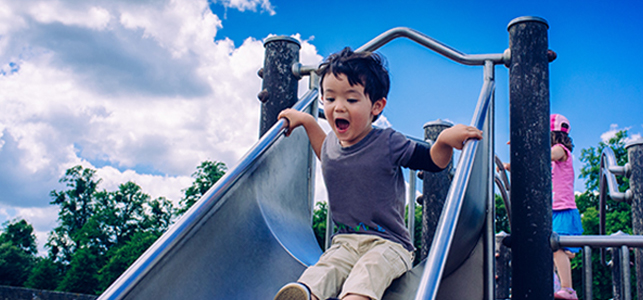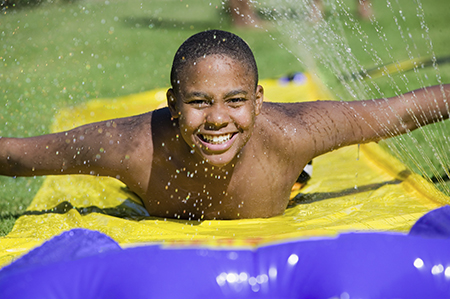
Summer means it’s time to PLAY! Along with fun in the sun (and water!) comes risk for concussion, a type of traumatic brain injury that can range from mild to severe. In the past week alone, our concussion team has seen kids for concussions from skateboarding, a slip n’ slide and a trampoline – but the most common cause of summertime concussions might surprise you!
Athletic Trainer Kassandra Kelly answers some of our top questions about concussions and how to keep kids safe this summer and all year round.
Overall, the number one cause of traumatic brain injury that brings children ages 0-5 to the emergency room is falling. In children ages 5-14, it’s being struck by or against an object.
During the summer months, the causes of pediatric concussion shift a bit with the playground being the most common culprit. According to the Centers for Disease Control and Prevention, children 0-4 most often sustain brain injuries on swings and slides. For older kids ages 5-14, swings continue to be a danger spot, along with monkey bars and climbing equipment.
 While we typically associate concussions with high-contact sports (and rightly so), playing on a playground and riding a bicycle are two of the top five causes of traumatic brain injuries seen in emergency departments, coming in only behind football and basketball.
While we typically associate concussions with high-contact sports (and rightly so), playing on a playground and riding a bicycle are two of the top five causes of traumatic brain injuries seen in emergency departments, coming in only behind football and basketball.
It’s also common to see concussions from other summertime recreational activities, including swimming, playing on a trampoline, and riding scooters and all-terrain vehicles.
1. Wear helmets!
It’s important that your child wears a properly fitted helmet while riding a bike, scooter, all-terrain vehicle or skateboard. While a helmet can’t prevent a concussion, it can reduce the risk of a skull fracture in the event of a fall. It is also important to check the helmet for any cracks or other damage prior to use, especially after a fall. Damaged helmets are not as affective at preventing injury and should be replaced.
2. Practice playground precautions
There are a number of steps you can take to help promote safety on the playground:
3. Be vigilant about water-related concussion hazards
Water activities are a great way to cool off during the heat of summer, and safety is key during these activities as well. Before allowing your child to enter a swimming pool, lake, river or pond, check the depth and clarity of the water. If you don’t know the depth, or can’t see what’s below the surface, make sure they DO NOT dive head first. Doing so can cause them to injure their head on the bottom or another object such as a rock. This not only can result in a head injury, but serious neck and facial injuries as well.
Caution should also be taken when using slip n’ slides and sprinklers. Check the ground for any tripping dangers and make sure to use a soft, level surface, with no hazards such as rocks or tree roots underneath. Check the slip n’ slide instructions for proper use and be sure it is positioned so there’s plenty of room to safely come to a stop at the end of the slide.
4. Supervise and recognize concussion symptoms
Regardless of what they’re doing, kids should be properly supervised at all times. Be aware of the signs and symptoms of concussion so you can remove your child from activity and seek proper treatment if needed.
While summer tends to be more relaxed, safe concussion recovery does still require attention to detail.
1. Maintain a routine sleep schedule
It’s important that your child maintain good sleep hygiene habits. Getting a good night’s sleep is vital to the recovery process, yet up to 80% of those who sustain a concussion report having some sort of sleep disturbance during recovery. Sleep disruption often contributes to things like concentration issues, memory problems, fatigue and moodiness, which are already common with concussion. Monitor your child’s sleeping habits and promote quality sleep every night.
2. Remember to hydrate
Proper hydration is an important part of your child’s recovery from a concussion. During the hot summer months, it’s especially easy to become dehydrated which can worsen concussion symptoms such as headaches, fatigue and dizziness. Encourage your child to drink plenty of water during their recovery and try to avoid sugary and caffeinated beverages that offer little nutritional value.
3. Be aware of social issues
After a concussion, some kids may feel isolated from their friends if they’re unable to participate in activities such as camp, sports and simply hanging out while they recover. They may also feel pressure to “get back out there” prematurely as they see their friends continuing with their normal summer activities. Check in with your child regularly to see how they’re coping.
4. Keep tabs on screen time
Use of technology, such as televisions, tablets and smart phones, can impact your child’s symptoms as they recover. Monitor technology use during recovery to see if it is negatively impacting symptoms and set appropriate limits if using technology is unavoidable.
Look for more tips on staying safe while having fun this summer.
References
Cheng, T. A., Bell, J. M., Haileyesus, T., Gilchrist, J., Sugerman, D. E., & Coronado, V. G. (2016). Nonfatal Playground-Related Traumatic Brain Injuries Among Children, 2001-2013. Pediatrics, 137(6), e20152721.
Sarmiento, K., Thomas, K. E., Daugherty, J., Waltzman, D., Haarbauer-Krupa, J. K., Peterson, A. B., Haileyesus, T., & Breiding, M. J. (2019). Emergency Department Visits for Sports- and Recreation-Related Traumatic Brain Injuries Among Children - United States, 2010-2016. MMWR. Morbidity and mortality weekly report, 68(10), 237–242.
TBI: Get the Facts. (2019, March 11). Retrieved June 12, 2020, from https://www.cdc.gov/traumaticbraininjury/get_the_facts.html
Playground Safety. (2019, February 6). Retrieved June 12, 2020, from https://www.cdc.gov/headsup/pdfs/parents/headsup_playground_safety_fs-a.pdf